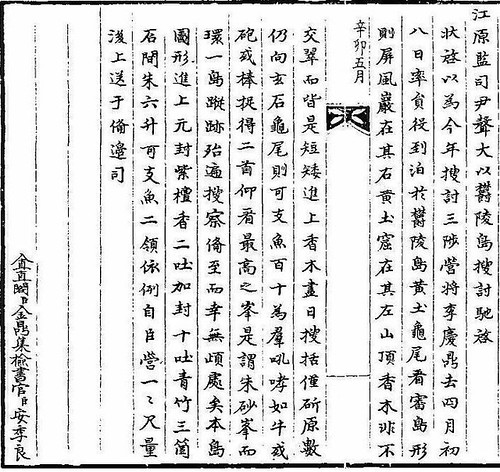This record is especially interesting because it said there was a herd of about 110 sea lions in the vicinity of Hyeonseok-gumi (玄石龜尾 - Hyeonseok Cove) and Jusa-bong (朱砂峯), which were on the north shore of Ulleungdo. Some Korean historians claim that Koreans used to travel ninety-two kilometers beyond Ulleungdo to Liancourt Rocks (Dokdo) to hunt sea lions, but this record clearly shows that these Koreans hunted their sea lions on Ulleungdo, not Liancourt Rocks.
Gangwon Governor Yun Seong-tae (尹聲大) Reports to the King about Ulleungdo Inspection.
On April 8th, Samcheok Commander Lee Gyeong-jeong (李慶鼎) lead low-ranking officials (員役) to Ulleungdo's Hwangto-gumi (黄土龜尾 - "Golden Clay Cove"), where they anchored. Surveying the geography of the island, they saw Byeongpung Rock (屛風巖 - "Folding Screen Rock") on the right and Hwangto Cave (黄土窟 - "Golden Clay Cave") on the left. The juniper trees on the mountain peaks had not yet changed colors (非不交翠) and they were all short and small. They searched the whole day for juniper to present to the king, but barely harvested more than they started with. They then headed to Hyeonseok-gumi (玄石龜尾 - "Black Rock Cove"), where they saw a herd of about 110 sea lions mooing like cows. They got two of them with guns and clubs. They looked up and saw the highest peak, which they judged to be the so-called, Jusa-bong (朱砂峯 - "Cinnabar Peak"). Thus, they proceeded to inspect around the island without incident.
I am presenting a map of the island and 2 pieces of rosewood incense (紫檀香), which are sealed in this letter. As is the custom, the subjects of the king will send ten more pieces of rosewood incense (紫檀香) , three green bamboo, six seung (升) of red ocher (石間朱), and two sea lions (可支魚). After each is measured, they will be sent to the Bibyeonsa (備邊司).
-----------------------------
江原監司 尹聲大以鬱陵島搜討馳啓
狀啓以爲今年搜討三陟營將 李慶鼎去四月初八日率員役到泊於鬱陵島黃土龜尾看審島形則屛風巖在其右黃土窟在其左山頂香木非不交翠而皆是短矮進上香木盡日搜括僅斫原數仍向玄石龜尾則可支魚百十爲群吼哮如牛或砲或棒捉得二首仰看最高之峯是謂朱砂峯而環一島蹤跡殆遍搜察備至而幸無處矣本島圖形進上元封紫檀香二吐加封十吐靑竹三箇石間朱六升可支魚二領依例自臣營一一尺量後上送于備邊司

GTOMR wrote;
ReplyDelete"間違っていたらすみませんが、が、(黄土X尾に着いたとき、)屏風岩が右にあり、黄土窟が左に有る、という記述だと思われますが、いかがでしょうか?"
看審島形則屛風巖在其右 黃土窟在其左山頂 香木 非不交翠而皆是短矮進上 香木
この一文ですね。地形が把握出来ていると、訳がより正確になりますよね。則にとらわれてしまったようです。
訂正版です。
他の部分は如何でしょうか?
江原監司 尹聲大 が鬱陵島の搜討についてご報告致します。
今年も搜討を行いましたのでご報告致します。 三陟營將 李慶鼎が去る四月八日に人員を率いて鬱陵島黃土龜尾へ到着し、泊まりました。島の形を観察しました。すると屛風巖が右にあり、黃土窟が左に在りました。山頂には 香木が短いけれど交わらずにまっすぐ上に伸びていました。香木を進上致します。昼になって探索を初めましたが、わずかに荒野があるばかりなので、玄石龜尾に向かいました。すると、アシカ?(可友魚) が百十者群れをなして牛の如く吼えていたので、棒などを使って二頭捕えました。最も高い峯を仰ぎ見ると、それが所謂朱砂峯です。島をぐるっとまわって殆ど全ての浜辺(?)捜索することが出来ましたので、大変幸いに思い、ここに、謹んで本島の地図(圖形)を進上致します。また、紫檀香 二吐に加えて、紫檀香 十吐靑竹三箇、 石間朱 六升 アシカ(可支魚) 二頭を同封します。例に習って、家臣の營一より一尺量を後で備邊司へ送ります。
TO Kaneganese-san
ReplyDelete斫原數仍向玄石龜尾
この部分ですが、
斫原數は、1918年の総督府地圖で、香木亭と玄浦の間にある香木亭の山のふもとの海岸付近(黒斫之)だと思われます。
その斫原數を越えると玄石龜尾があるといった描写だと思います。
http://dokdo-or-takeshima.blogspot.com
/2007/11/1918
-japanese-map-of-ulleungdo.html
少し修正しておきました↓
Compare the discription above 1831 and the map of Ullungdo below(古2701-02).
http://www16.tok2.com/home/otakeshimaoxdokdox/
1831Analasysmapofulleungdo.JPG
江原監司 尹聲大が鬱陵島搜討について国王に申し上げた
ReplyDelete今年搜討した三陟營將 李慶鼎は去る四月初八日に随行者を率いて鬱陵島の黄土龜尾に到着して宿泊した。島の形を概観してみるならば、即ち屏風巖がその右にあり、黄土窟が其の左にある。山頂の香木は交翠(ひすいを交ぜあわす・意味不明)ではないものはなく皆短く矮小である。献上する香木はことごとく搾取して原数(原数・意味不明)をわずかに削った。玄石龜尾に向かって行くと百十頭ほどのアシカが群れを成して牛のようにおたけびをあげていた。鉄砲を使ったり棒でたたいたりして二頭を捕まえた。最高峰の山を仰ぎ見るにこれを朱砂峯という。
このようにしてつつがなく島を一周し踏み跡をあまねく調査することが出来た。本島の図形を献上し元封の紫檀香2個加封(の紫檀香?)10個青竹3個石間朱六升アシカ2頭を臣下(臣下=私)の陣営から前例に従って一つずつ重さを量った後で備邊司に送り届けた。敬語をつかうべきでした。。
Yabutarouさん
ReplyDeleteありがとうございました。
早速、英訳しますね。
Gerry, this is the translation, though we are not perfectly sure about how to treat 斫原數 part. Please correct my English and make it elegant...
ReplyDelete江原監司 尹聲大 reported king about Ulleundo inspection.
On 8th of April, 三陟營將 李慶鼎 lead the others, and he reached to 黄土龜尾 in Ulleundo and stayed there overnight. When he saw the shapes of the island from there, there was 屏風巖 on the right and 黄土窟 on the left. There were no aromatic trees which are not "交翠"(← We don't know what it means. Maybe a some kind of green colour?) and they are all short and small. We cut all the aromatic trees to make a present of king and shaved a bit of "原数" ( Or if "斫原數" is a proper noun as GTOMR thinks, the sentence should be "We searched for the aromatic trees for a king's present whole day, but we had only a few in 斫原數. ) Then we went to 玄石龜尾 and saw a 110 of sealions hawling like a cow. We captured two of them with a bat and so on. When we look up the highest mountain, we see so-called 朱砂峯.
Thus we could succeed in inspecting around the island without any harm. I will offer the map of this island and 2 of aromatic tree(紫檀香) which I sealed in this letter. Addition to that, we, the subjects of the king sent 10 more aromatic tree(紫檀香) , 3 blue bamboos, 6升 of 石間朱 and 2 of sealions to 備邊司 after mesuring each of them following with precedent.
交翠 is the good tree's expression in the Chinese poem that the leaf and branch crossing.
ReplyDelete(翠 is green/green color)
Im not sure because lack of other examples,I guess they miswrite "敷"as "數", but better to postpone the part and wait reply Yabatarou-san.
Great job, you guys. Thanks.
ReplyDeletePlease check and make sure I did not mess up the translation with my edits.